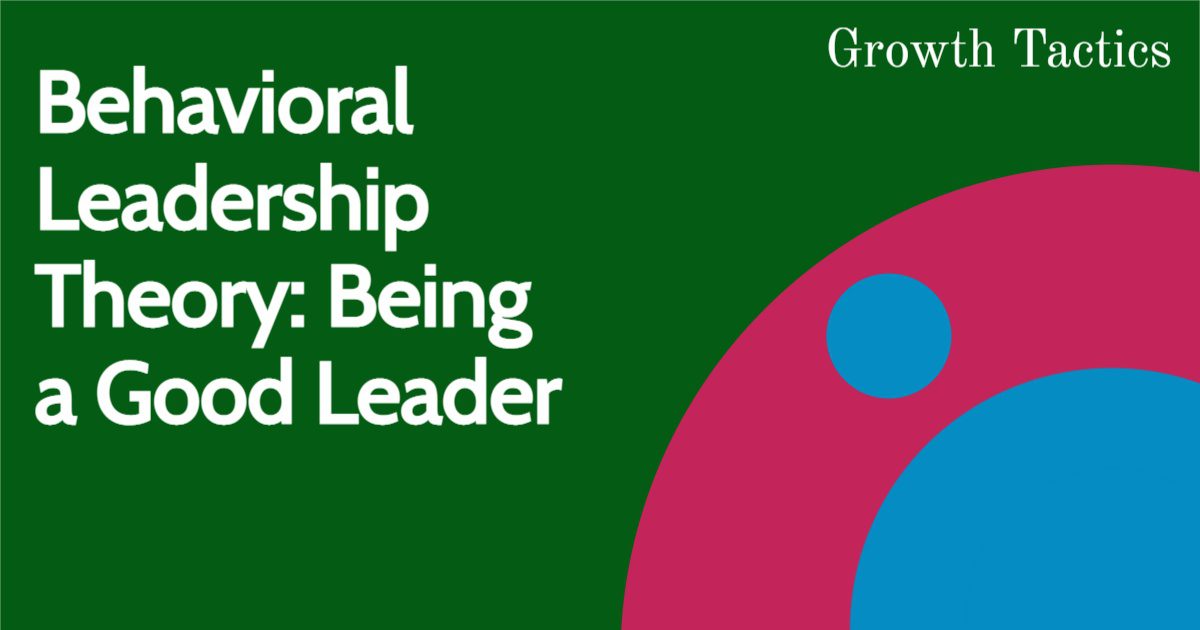There are many ways to be a leader, and no one way is the best. In fact, many different types of leadership styles can be effective in different situations. Behavioral Leadership Theory is one of the most popular frameworks for helping people learn about leadership. This article will give you the basics of what this theory is all about so that you can decide whether or not it’s right for your situation!
Jump To Section
What Is Behavioral Theory of Leadership
Behavioral Leadership Theory is a theory of leadership that focuses on the behavior of leaders and how they impact followers.
In the mid-1900s, Kurt Lewin developed a model for understanding leadership. Later on, an associate of his named Rensis Likert refined it in order to describe how leaders influence followers.
The two main components of this theory are:
- The Leader’s Personal Attributes (e.g., intelligence, skills)
- The Leader’s Behaviours (e.g., communication style)
The Leader’s Personal Attributes The first part of this theory focuses on the leader’s personal attributes. Specifically, it looks at how a leader’s intelligence, skills, and values impact their ability to influence others. It also considers what type of person they are (e.g., extrovert vs introvert).
Styles of Leadership
There are several different leadership styles you can use to influence your team. For example, you might be a big-picture leader who focuses on the overall direction and vision, or you may be more task-focused and direct employees in their day-to-day work.
While all of these styles are valid, it’s important to remember that they do not encompass every effective way of leading an organization effectively. You might think about which style suits your personality best before deciding on your approach; however, if you’re not sure what type of behavioral leadership will work for your organization or team members, some general guidelines can help guide this decision:
- Some leaders are task-oriented while others are relationship builders. Knowing which one fits best will make it easier for everyone involved (bosses included).
- If there’s too much focus on one aspect without equal consideration given to the other half (like trusting employees with little guidance), then mistakes will inevitably occur due to miscommunication between the parties involved!
Democratic Leadership Style
Democratic leadership is a style of leadership that involves the involvement of people in decision-making. This can be done through an informal consensus-building process or a formal process such as voting or surveys.
Democratic leaders make decisions with the input of others and are open to suggestions from their employees. They make themselves accessible to all employees, share information with them, and welcome criticism.
This style of leadership is very effective for environments that require a lot of creativity, innovation, and change. It also works well in situations where employees are highly motivated and have a high level of education. This is because it allows them to be involved in decision-making processes and makes them feel valued by the company.
Authoritarian Leadership
Authoritarian leadership is the most common type of leadership. It’s also the least effective. Authoritarian leaders want to control and dominate their employees. They have a “command and control” mentality, which means they believe they know what’s best for everyone, so they don’t ask for employee feedback or advice.
Authoritarian leaders don’t seek out their employees’ ideas because it would mean giving up some control over them.
Authoritarian leaders don’t show compassion, because they believe it makes them look weak and makes you question their decisions. They want nothing more than for their people to follow orders without question or hesitation because who knows better than them?
Servant Leadership Style
Servant leadership is a style of leadership that focuses on the needs of the people being led. These leaders make their primary interest in taking care of their followers and treating them with dignity and respect. In this way, servant leaders are able to motivate their teams by creating an environment where people feel safe and comfortable coming forward with ideas or issues they need help with.
Servant leaders do not use fear as a motivator for their staff. Instead, they inspire them through trust and confidence in one another’s abilities. Servant leaders act as stewards by managing resources carefully and responsibly, both those that belong to themselves personally, as well as those entrusted to them in their capacity as leaders (for example budgets).
They also work hard to ensure everyone feels valued within the group they lead. No matter if they’re high-performing employees or new team members who haven’t yet proven themselves but still deserve respect all the same!
See Related: 10 Proven Servant Leadership Characteristics You Can Build
Country Club Leadership
This type of leadership is all about taking care of employees. The emphasis is on caring and nurturing, not on getting production out of employees.
The leader wants to help his or her team succeed in any way possible. But they won’t push their members too hard if they are underperforming because they don’t want to see them get hurt or become unhappy.
The leader wants their employees to feel like they are part of a family, and they want to be loved and appreciated by those who work for them. This type of leadership is often seen within small businesses or organizations. Where people know each other well and have worked together for many years.
Transformational Leadership
Transformational leadership is a theory that suggests that the most effective leaders are those who have a vision for the future, inspire others to achieve it, and act as examples for their followers to emulate. In order to be this kind of leader, you need to:
- Have a vision for the future
- Inspire others to achieve that vision
- Act as an example for those around you
Transformational leadership is a type of leadership that focuses on creating change within an organization. This type of leadership is often seen in large corporations. People may not know each other well, but they need to come together to achieve a common goal. The theory behind transformational leadership says that the most effective leaders are those who have a vision for the future, inspire others to achieve it, and act as examples for their followers to emulate.
See Related: Charismatic Leadership Characteristics and Examples of Great Leaders
Transactional Leadership
If you’re looking to be a transactional leader, it means that your focus will be on the task at hand. This type of leadership often leads to positive outcomes for both the employee and employer. A good example of this would be if an employee does something right like hit a sales number and then gets a bonus because of it.
Transactional leadership is effective when the leader and follower have a clear understanding of their roles. It works well in environments where leaders are focused on what needs to be done. And followers are motivated by rewards or punishments.
Laissez Fare Leadership
This style of leadership involves delegating tasks to your team members. And allowing them to decide how to complete the task. The leader also allows the team members to decide on the best way to achieve the goal. This is more of a hands-off approach as compared to other styles. The leader provides a clear vision and direction for his or her group/team by communicating what needs to be done, why it needs to be done, and when it needs to be done for everyone to succeed in their mission or objective.
The leader must be able to trust that each member of the group understands what needs doing, why it needs doing, and when it will be done if he or she is going to have success with this method of leadership.
See Related: How to Be More Charismatic (21 Surefire Ways)
Task Orientated Leadership
Good task-oriented leaders focus on the task at hand. They avoid distractions and don’t worry about what other people are doing, what other people think or will say, or what other people will do.
They focus on the present and what they can change. The task-oriented leader is a doer, not a talker. He or she gets things done instead of waiting for others to do them. The task-oriented leader doesn’t worry about why something needs doing. But rather focuses on how it can be done to get results.
Impoverished Leadership Style
The impoverished leadership style is one of the most common poor leadership styles. This type of leader places little to no value on employee satisfaction and instead prioritizes productivity above all else. While this might seem like a short-term strategy that would yield results. This kind of “leadership” actually has long-term consequences for both the workplace and those who work there.
Servant Leadership
Servant leadership flips the traditional view upside down. Here, the leader serves the team. They prioritize their team’s growth and well-being above all. Think of it as leading from behind, ensuring everyone moves forward together. Why not be the leader who lifts others?
Distributed Leadership
Ever seen a team where everyone steps up? That’s distributed leadership. It’s the belief that leadership isn’t just for the person at the top. Leadership tasks are shared, tapping into the team’s collective knowledge. Give it a try. Encourage everyone to take the lead sometimes.
Authentic Leadership
Be real. That’s the core of Authentic Leadership. It celebrates leaders who are genuine and transparent. These leaders know themselves well and stick to their values. Want followers to trust you? Start by being your true self.
Adaptive Leadership
Change is constant. Adaptive Leadership is all about navigating through change. Leaders encourage their teams to tackle tough challenges and adapt. It means letting go of outdated methods. Ready for change? Lead the way in adapting.
Cross-Cultural Leadership
In our global world, understanding Cross-Cultural Leadership is crucial. It’s about leading across different cultures. Good leaders recognize these differences and adapt. Thinking of going global? Embrace cultural diversity.
Workers in this type of environment are unlikely to feel motivated or inspired by their leaders. They may even be demoralized by their lack of personal growth opportunities or financial compensation. In addition to being emotionally unfulfilling and stressful, these types of workplaces can also be dangerous and not just physically! They may have high rates of employee turnover due to low morale among workers. Employees will likely leave immediately once given the chance.
See Related: Hierarchal Vs Flat Organizational Structure: Pros and Cons
What is the Great Man Theory?
Have you ever thought that some people are just born to be leaders? That’s what the Great Man Theory suggests. This theory believes that great leaders are born, not made. It tells us that leadership is an innate trait, something you can’t learn or acquire through experience.
According to this theory, history is shaped by extraordinary leaders. These leaders are naturally born with the qualities that make them effective. Think of well-known figures like Winston Churchill or Martin Luther King Jr. The Great Manuscript Theory sees these leaders as heroes who rise during critical moments and lead their followers toward significant achievements.
So, if you ever wondered why some people seem to command attention and lead groups naturally, the Great Man Theory offers an explanation. It suggests there are inherent traits that make certain individuals stand out as “natural leaders.”
In essence, the Great Man Theory is a way of looking at leadership that emphasizes the role of inherent qualities over learned behaviors. Remember, it’s just one way to understand leadership, and many other theories offer different perspectives on how individuals come to be great leaders.
Understanding the Contingency Theory of Leadership
Have you ever wondered why some leaders thrive in certain situations but not in others? Enter the Contingency Theory of Leadership. This theory tells us that there is no one perfect way to lead. Instead, how effective you are as a leader depends on the circumstances you find yourself in. Let’s dive deeper.
The Core Idea
At its heart, the Contingency Theory argues that the best leadership style isn’t fixed. It changes based on the team’s needs, the task at hand, and the environment. Think of it as matching your leadership approach to the situation you’re facing. It’s about being adaptable.
Why It Matters
Why does this matter to you? Knowing this theory can make you a better leader. You’ll start paying attention to what your team needs and how you can adjust your style to lead them more effectively. It’s about finding the right fit for the moment.
How It Works
How do you apply this theory? It starts with understanding your leadership style and your team’s needs. Are they looking for clear direction or more freedom to explore? Then, look at the task. Is it complex or straightforward? Finally, consider the work environment. Is it changing rapidly, or is it stable?
Your job as a leader is to adapt. Sometimes, you might need to be more directive. Other times, it’s about stepping back and letting the team take the lead.
Real-World Application
Think about a sports coach. Their approach changes based on the game’s score, the opponent, and even the weather. They’re using Contingency Theory in action.
By embracing this approach, you prepare yourself to navigate the complexities of leadership with more insight and adaptability. Start observing your environment and adjusting your style. It might just be the key to unlocking your team’s potential and leading them to success in various situations.
You Can Use These Theories to Help You Be a Better Leader
You can use these theories to help you develop your leadership skills. Use them to determine what type of leader you are and how to improve, whether as a leader or a follower. You can also use it to understand other people’s leadership styles, allowing you to work with them more effectively.
Behavioral Leadership Theory is a great way for anyone who works in any kind of organization, from small businesses up to Fortune 500 companies, to improve their performance and enhance their careers.
So, how can you use behavioral leadership theory to become a better leader? Here are a few tips:
Tip #1: Listen Actively
Active listening is key to effective communication, and effective communication is at the heart of successful leadership. When you actively listen to team members, you show them that their perspectives, experiences, and ideas matter.
Tip #2: Set Clear Expectations
One of the most important things a leader can do is to establish clear and realistic expectations for their team. This involves acknowledging each team member’s strengths and weaknesses and breaking down tasks in a way that plays to those strengths.
Tip #3: Encourage Open Communication
Effective leadership requires creating a positive workplace culture that fosters mutual respect, trust, and open communication. This can be achieved through regular check-ins with your team members, facilitating team-wide brainstorming sessions, and creating a space where team members can freely voice their concerns and suggestions.
Tip #4: Adapt Your Leadership Style
Different situations may require different leadership styles. As a leader, it’s important to be flexible and adaptable when leading your team. For example, in a high-pressure situation, a more authoritarian approach may be needed. But, in a situation that requires innovation and creativity, a more laissez-faire approach may be more effective.
By adopting these tips, you can become a better leader and create a more productive and engaged team. So, start using behavioral leadership theory to your advantage today and see the positive impact it has on your workplace.
How to Pursue Leadership Development
Leadership isn’t just about being in charge. It’s a journey of growth and self-improvement. Whether you’re starting out or have years of experience, there’s always room to enhance your leadership capability. Here’s how to focus on leadership development in practical, achievable steps:
Reflect on Innate Traits and Acquired Skills
Start by looking inward. Identify your innate traits, those things that come naturally to you. Are you empathetic? Decisive? Then, consider the skills you’ve already acquired. Leadership is not just about what’s inborn. It’s very much a learnable behavior.
Embrace Continuous Learning
The best leaders never stop learning. Enroll in workshops or courses. Ohio State University and the University of Michigan offer resources that might help. Many theories, like behavioral or situational theory, provide valuable insights into leadership effectiveness.
Understand the Behavioral Approach
Study the behavioral theories of leadership. These focus on observable actions. Know the difference between task-oriented and people-oriented behaviors. Both play a significant role in leadership success. Remember, the ideal leadership style often blends the two.
Assess and Adapt Your Management Style
Leaders must adapt to the specific situation at hand. Fiedler’s contingency model suggests that the effectiveness of a leader is dependent on how well their leadership style fits the context. Reflect on your own style and be prepared to adapt to the needs of your group members.
Improve Your Emotional Intelligence
Emotional intelligence is a key indicator of leadership success. It’s about understanding your own emotions and those of others. Work on your communication skills, empathy, and social [skills](#). They can enhance team performance and job satisfaction.
Seek Feedback and Mentorship
Ask for feedback on your leader behaviors. This can give you a clear perspective on your leadership roles and how they impact others. Seek out mentors who exemplify effective leadership. Learning from others’ successes and mistakes accelerates your own leadership development.
Foster a Positive Work Environment
Promotion of a positive work environment can lead to better team performance and job satisfaction. Actions of leaders like showing appreciation and encouraging open communication are vital. People-oriented leaders know that the well-being of their team is crucial.
Engage in the Decision-Making Process
Participative leadership, where decisions are made collectively, can be very effective. Involve group members in the decision-making process. This not only empowers them but can lead to better decisions, as it incorporates diverse perspectives.
Keep the Big Picture in Mind
Leadership development isn’t a one-size-fits-all. It’s influenced by contextual factors like the business environment and the psychology of human behavior. Always consider these factors when applying what you’ve learned to your own leadership ability.
Remember, every step you take toward developing your leadership skills is a big leap toward your ideal leadership role. Stay committed, stay curious, and balance the right mix of behaviors to thrive as a leader.
Conclusion
We’ve covered a lot of ground in this article. Hopefully, you now have a good idea of how to be a better leader. If you want to take it to the next level, it’s worth looking at other theories such as situational leadership theory or transactional leadership theory. These are useful in that they allow you to customize your leadership style based on the situation at hand and the people involved.
Did you find this article on behavioral leadership theory useful? Share and subscribe below.








